![]()
![]()
![]()
Use LEFT and RIGHT arrow keys to navigate between flashcards;
Use UP and DOWN arrow keys to flip the card;
H to show hint;
A reads text to speech;
44 Cards in this Set
- Front
- Back
- 3rd side (hint)
|
Larynx extends from |
Root of the tongue to trachea |
|
|
|
Length of larynx in male and female |
44 and 36 |
|
|
|
Unpaired cartilages of larynx |

1. Cricoid 2. Epiglottis 3. Thyroid |
CET |
|
|
Paired cartilages of larynx |

1. Arytenoid 2. Corniculate 3. Cuneiform |
ACC |
|
|
What forms laryngeal prominence |
Fusion of right and left thyroid cartilage |
|
|
|
Cricoid cartilage is shaped like |
Ring |
|
|
|
Narrow anterior part of cricoid cartilage is |
Arch |
|
|
|
Broad posterior part of cricoid cartilage is called |
Lamina |
|
|
|
Epiglottis is what shape |
Leaf shape |
|
|
|
Arytenoid cartilage is |
Pyramid shape |
|
|
|
What shape is Corniculate cartilage |
Conical nodules |
|
|
|
What shape is Cuneiform cartilage |
Rod shape |
|
|
|
Which cartilages are hyaline? |
Thyroid, Cricoid and basal parts of arytenoid |
|
|
|
Which cartilage are elastic? |
Epiglottis, corniculate and cuneiform and process of arytenoid |
|
|
|
What are the two laryngeal joints? |
Cricothyroid Cricoarytenoid |
|
|
|
CriciThyroid joint permits movement in |
Transverse axis |
T |
|
|
Cricoarytenoid joint permits movement in |
Vertical axis |
|
|
|
Name the extrinsic laryngeal ligaments |

1. Hyoepiglottic 2. Thyrohyoid 3. Cricotraceal |
HTC |
|
|
Name the intrinsic laryngeal ligaments |
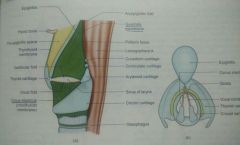
1. Quadrate membrane 2. Conus elasticus |
|
|
|
Upper border of quadrate membrane is |
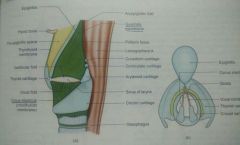
Aryepiglottic fold |
|
|
|
Lower border of quadrate membrane is |
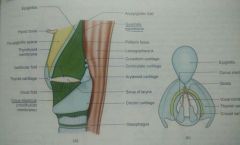
Vestibular fold |
|
|
|
Anterior thick part of conus elasticus forms |
Cricothyroid ligament |
|
|
|
Upper free border of conus elasticus forms |

Vocal fold |
|
|
|
Space between vestibular fold |
Rima vestibuli |
|
|
|
Space between vocal fold |
Rima glottidis |
|
|
|
Narrowest part of larynx is |
Rima 23 mm in males 17 mm in females |
|
|
|
Part between vestibular and vocal fold is |
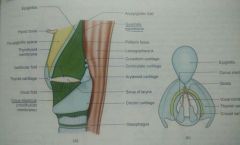
Sinus or ventricle of larynx |
|
|
|
Cleft between vestibular and vocal folds is |
Sinus of morgagini |
|
|
|
Diveticulum in anterior part of sinus |
Saccule of larynx Oil can of larynx |
|
|
|
Intrinsic muscles of larynx |
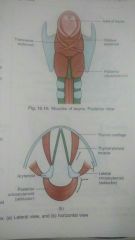
Cricothyroid Post cricoarytenoid Lateral cricoarytenoid Transverse arytenoid Oblique arytenoid Aryepiglottic Thyroarytenoid Thyroepiglottic Vocalis
|
|
|
|
Elevation of larynx |
Thyrohyoid, mylohyoid |
|
|
|
Depression of larynx |
Sternothyroid, sternohyoid |
|
|
|
Opening inlet of larynx |

Thryoepiglottic |
|
|
|
Closing inlet of larynx |
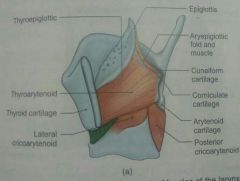
Aryrpiglottic |
|
|
|
Abductor of local cords |
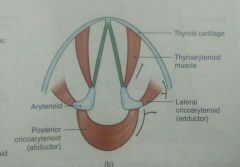
Posterior cricoarytenoid |
|
|
|
Adductor of vocal cords |
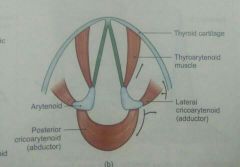
Lateral cricoartytenoid Oblique arytenoid Transverse arytenoid
|
LOT |
|
|
Tensor of vocal cords |
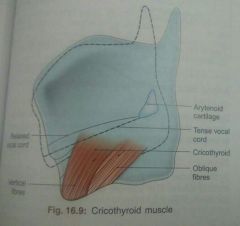
Cricothyroid |
|
|
|
Relaxor of vocal cords |
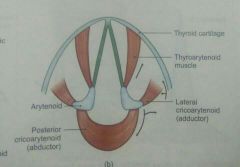
Thyroarytenoid and vocalis |
|
|
|
Shape of vocal folds during quiet breathing |
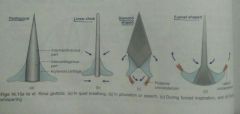
Pentagonal |
|
|
|
Shape of vocal folds during speech |
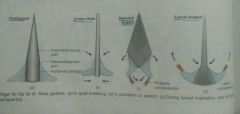
Chink |
|
|
|
Shape of vocal folds during forced inspiration |
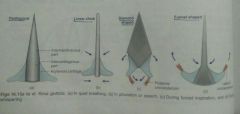
Lozenge or diamond shape |
|
|
|
Shape of vocal folds during whispering |

Funnel shaped |
|
|
|
Motor Nerve supply |
Recurrent laryngeal nerve Except cricothyroid supplied by external laryngeal nerve |
|
|
|
Sensory nerve supply |
Internal laryngeal nerve above vocal fold Recurrent laryngeal nerve below vocal fold |
|

